A Beginner’s Guide to the Matrix Organizational Structure
When we hear the phrase “organizational structure,” often, we imagine a hierarchical structure that looks something like this:
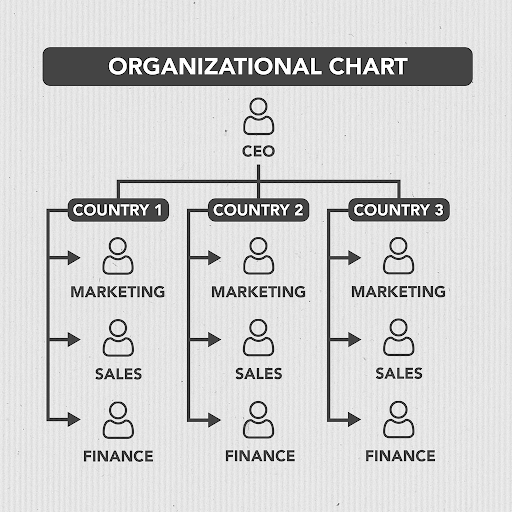
In this divisional organizational chart, department heads report to the country manager, who reports to the CEO. Image source: Author
This structure clearly defines the organization’s reporting relationships. There is also just one chain of command, no ambiguity in terms of who reports to whom, and managerial roles are fixed.
However, traditional corporate hierarchies only work well when the people within them work in isolation, also called siloes. They don’t lend themselves well to large-scale projects involving cross-functional teams, where knowledge and resources are often shared.
This is where the matrix organizational structure comes in.
Overview: What is the matrix organizational structure?
An organizational structure is a system that outlines the hierarchy of an organization and defines how roles, responsibilities, and activities are directed in order to achieve the company’s business development goals. There are several organizational structure types, and each is represented by the organizational chart.
The matrix structure, as its name suggests, is a reporting structure that’s set up like a grid or matrix. In a traditional hierarchy, people in the company report to just one boss. In a matrix organization, employees report to both a functional manager and a product or project manager.
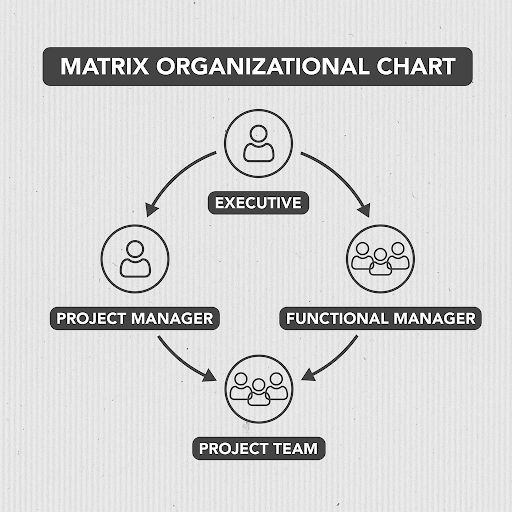
The basic building blocks of a matrix organizational structure. Image source: Author
Like most products or solutions, the matrix-type organization structure came about in response to a need. Projects, problems, and product lines became more complex and demanded flexible, collaborative environments that traditional hierarchies were ill-equipped to support for a variety of reasons, including:
- Miscommunication: Messages can be interpreted differently as they’re passed down from manager to supervisor to employee.
- Slow decision-making: Decision-making is centralized and made largely by the people at the top of the food chain, who often are too far from the action or work being carried out. There are rules for every type of decision made and documents to create for recordkeeping.
How does the matrix organizational structure work?
The matrix organizational or management structure works by grouping employees and resources by function and by product or project. An employee from the design department may be assigned to a project team -- IT Project Sandpaper, for example -- and would have to report to two bosses, or more, depending on the number of projects they’re assigned to at any given time: Project Sandpaper’s project manager and the design department head.
The matrix is temporary in nature and is designed to last only for the duration of a project. This structure type offers both advantages and disadvantages to project management:
Advantages
- More efficient use of limited resources: Employees and other matrix resources can be quickly transferred from one project to another, depending on the need.
- Encourages open communication: In top-down organizations, employees rarely communicate with key decision-makers. Instead, their roles and duties are cascaded to them by their managers or supervisors. In a matrix, employees are expected to directly communicate with project managers and their respective functional supervisors.
- Exchange of knowledge: Matrix organizations provide employees with the opportunity to work on different projects with different teammates. This facilitates the exchange of information, expertise, and skills among colleagues.
Disadvantages
- Conflicting employee loyalties: Project and functional managers not agreeing on issues happens quite a lot. Because staff report to both of them, there’s a possibility of project team members being caught in the crossfire.
- Wasted time because of too much communication: Meetings and stand-up sessions have their uses, but schedule too many and you risk taking crucial time away from important work.
Should your small business use the matrix organizational structure?
Like many of the best project management tools out there, the matrix organizational structure has both critics and proponents. It’s arguably one of the most complex structures in use today, but done right, certain situations can benefit from it.
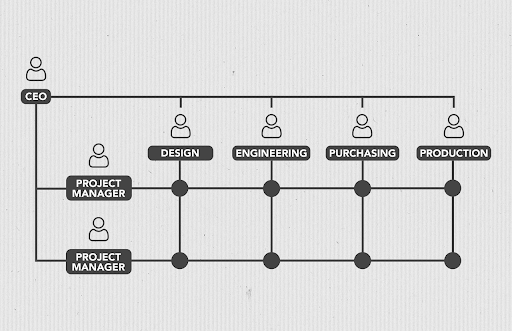
Organizations using a matrix structure assign function-specific roles to projects or products. Image source: Author
There are two chains of command, so an employee reports to two managers.
When using the matrix structure makes sense
Hiring new people to establish a dedicated project team is a costly endeavor, and many small businesses are already cash-strapped as is.
Matrix management enables companies with tight purse strings to maximize whatever resources they already have. It lets you share resources and employees across functions to develop new products or solutions, helping you create a stronger, more diverse project team in the process.
When you should use another organizational structure
The flexibility of the matrix team structure has several upsides. However, certain situations are not cut out for it, such as:
- When certain skill sets are critical to a business function: Pulling out people with vital skills from a specific department to join project teams, albeit temporarily, may lessen the usefulness of that business function.
- When a project is expected to continue for the long term: Sharing of people and resources through the matrix system is a temporary solution. If a project is expected to continue for a while, it’s better to create a dedicated team in which team members are assigned permanent roles.
The best project management software for a matrix organizational structure
One of the basics of project management that will undoubtedly help your organization maximize the benefits of the matrix structure is the use of project management tools.
Gantt charts let you visualize project tasks against the project’s timeline, a prioritization matrix helps you decide which tasks or activities should take priority, while project management software provides a centralized location for team files, schedules, updates, and communications.
Here are a few project management software options you can check out to make matrix management work for your team.
1. Podio: communication and collaboration
In a matrix structure, the project management process relies on team collaboration and open communication for success. One of the main responsibilities of a project manager is to create a project communication plan that all project stakeholders are expected to follow throughout the life cycle of the project.
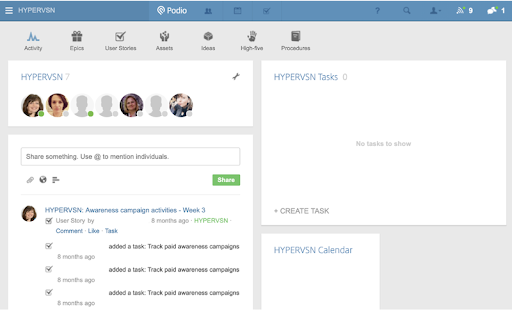
This is what Podio’s social feed looks like. Image source: Author
With Podio, your team has a centralized workspace for updates, comments, and files. Upload your project plan and other necessary project documents into Podio for easy, on-demand access by everyone on the team.
Aside from a social network-like feed system to keep everyone in the loop, Podio also comes with meeting scheduling, personal dashboards, and integrated chat.
2. Wrike: resource planning
Getting resource planning right is one of the major principles of project management. Small business owners share people and resources across functions to minimize costs. But you also don’t want to burn people out or underutilize some of them, making a project management tool with essential resource planning features vital for success.
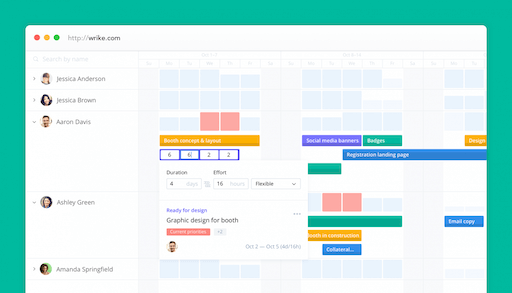
Wrike’s resource management feature. Image source: Author
Wrike’s resource management system will show you what everyone is doing, allowing the project manager to more efficiently respond to requests, distribute tasks, and keep team members’ workload balanced. It shows which tasks are being worked on and when, ensuring you’re maximizing everyone’s strengths and capacity.
If change management is necessary to keep projects on time and within budget, Wrike gives you real-time visibility into the overall status of the project, allowing you to make the needed process improvement and personnel adjustments in a timely manner.
3. monday.com : budget management
Developing a project risk management plan is an essential component of the project planning phase, one of the five steps of project management. One potential risk that project managers should watch out for is the project budget going out of control, regardless of the organizational structure being followed.
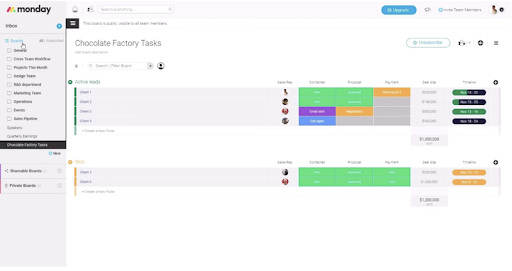
Use monday.com’s numbers feature to track budgets and expenses. Image source: Author
With monday.com, you can use the numbers column to set budgets and create your budget dashboards. Budgets can be per activity, per event, or per person, depending on what makes the most sense. If you only need to view specific data, you can filter your dashboard by person, status, etc.
If you need advanced Excel type formulas to keep track of budgets and expenses, use monday’s formula column.
Making the matrix structure work for your needs
The matrix organizational structure has its uses and drawbacks. It allows for the efficient use of limited resources, but it’s not the answer to every situation. If the required tools, processes, and principles are not implemented correctly, things can get complicated really fast.
Because employees need to report to at least two managers, the right amount of communication and active participation is crucial for success.
Alert: our top-rated cash back card now has 0% intro APR until 2025
This credit card is not just good – it’s so exceptional that our experts use it personally. It features a lengthy 0% intro APR period, a cash back rate of up to 5%, and all somehow for no annual fee! Click here to read our full review for free and apply in just 2 minutes.
Our Research Expert
We're firm believers in the Golden Rule, which is why editorial opinions are ours alone and have not been previously reviewed, approved, or endorsed by included advertisers. The Ascent does not cover all offers on the market. Editorial content from The Ascent is separate from The Motley Fool editorial content and is created by a different analyst team.
Related Articles
View All Articles